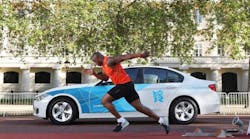Will humans ever be able to outrun a car? Answering this question will definitely require more physics than logic. One needs to understand how velocity changes with time (acceleration) as well as how to track the acceleration of two or more objects which race simultaneously within a specified distance. In our case, our objects include a human being and a car; once we establish which of the two objects has a higher acceleration, our question will be answered.
Bolt vs. a Car
From the onset, we must appreciate the fact that humans cannot compete with cars- machines- over long distances. From recorded statistics, elite human runners accelerate for up to 5 sec. and then from that point on, they run at a constant speed. Usain Bolt, the Jamaican 100-meter runner who holds the record as being the fastest human to have ever walked the surface of the earth, has an acceleration of between 8m/s2 and 10m/s2. A car, on the other hand, can record an initial acceleration of 10m/s2. If Bolt was to race against a car, who would win?
Of course, Usain Bolt will have an initial advantage over the car because he can start accelerating in a jiffy. All systems go; a car will need several microseconds before it starts accelerating. Therefore, in the first two seconds, Bolt will be a few strides ahead of the car. Using Newton’s laws of motion, when the initial velocity is zero, the distance (S) is related to time (t) and acceleration (a) by the equation 2S = at2. In the case of Bolt…
Max acceleration: 10m/s2
Time: 2 s
Solving for S would yield (10 X 22)/2 meters from the starting point after two seconds, which equals 20 meters. What that means is that all factors held constant, Usain Bolt can outrun a car within the first 20 meters in a 100m race.
A study in 2012 done by sports scientist Greg Whyte with the acceleration of Olympic gold medalist Mark Lewis-Francis showed that Lewis-Francis was able to stay in front of a BMW 320d for about 4 sec. This meant he was able to stay in front of the car for just under 30 meters.
But what happens after the first 20 meters? Bolt stops accelerating and starts to run at a constant speed of 10m/s. That’s the point where the car catches up with him. But with a lorry or other large vehicles that move at speeds less than 6m/s, Bolt will beat them hands down within the first 100 meters or more. Who knows? Maybe he can keep the speed for longer if he needed to. The only disadvantage that would make him lose to the lorry, in the long run, is his inability to breathe in enough oxygen while running at top speed. The human heart, and lungs aren’t designed to circulate air efficiently to the entire body during intense body exercises such as running.
Is There Anything That Humans Can Do In Order To Outrun Cars?
Hypothetically, studies suggest that humans can run at a constant speed of 65 km per hour. That’s about 18m/s, almost double the speed of the world’s fastest man: the aforementioned Usain Bolt. But why is this speed unattainable in reality? One would assume that it is because human limbs aren’t designed to handle the immense weight that a runner must subject them to when running at top speed. We are talking about 1,000 lb. of weight in each single step. But that’s not the case.
According to Peter Weyand, a researcher at Southern Methodist University, human limbs can actually handle more than 1,000 lb. of force for as many steps. The researcher was among the lead scientists at the university who conducted a study on multiple people running on treadmills, concluding that weight wasn’t a hindrance to our ability to run at 18m/s.
The real hindrance to humans competing effectively with cars is the time and energy that we end up wasting between the time the foot hits the ground and the time it leaves the ground to take a stride. Weyand and his group established that when sprinting, the foot-ground contact time limits how fast people run. The muscle fibers must spend a lot of energy in order to get the foot from the ground, back to the ground, and then up again. That sequence limits how fast you can run.
If humans can eliminate the dragging effect of the foot-ground contact force and time, then we definitely can outrun a car for short distances. Perhaps we don’t have much say in how much oxygen our nostrils can inhale in one go or how fast the lungs and the heart can circulate blood in our body in order to sustain top speed, but we definitely can do something about this limiting foot-ground contact force. One way this is possible is using the right running shoes and investing if effective running training plan.










